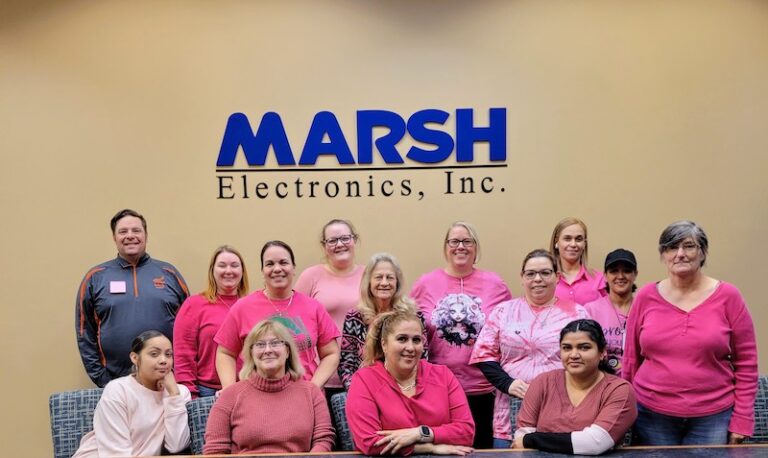Fluoropolymer Insulation Etching for Bonding Applications in Harness Assembly
Materials like TeflonÒ, PTFE, FEP and PFA are widely used in our industry for wire insulation. Their chemical and heat resistance, low coefficients of friction and stellar dielectric qualities make them the obvious choice for use in many high-reliability wiring applications (see How to Select a Polymer for High Temperature Wire and Cable in the March/April issue on wiringharnessnews.com). Their high lubricity, however, greatly reduces the bonding ability of the insulation. In order to bond, mark, pot, or mold to these materials, they must be etched in some fashion.
This task is most commonly achieved using a chemical enchant solution. Some high-reliability space applications call for additional roughing of the surface with abrasives like sandpaper.
An illustration of the effects of etching to the insulation surface is shown in Figure 1.This article deals primarily with the chemical process, and WHN was fortunate to have Amy Ricketts of Connectronics to guide us through this subject.
First, let’s cover some basics. The etching process is achieved by placing the fluoropolymer wire into a sodium solution (two brands are listed in the Rescources section at the end of this article). The resulting chemical reaction removes fluorine molecules from the carbon-fluorine backbone of the fluoropolymer surface. This leaves a carbonaceous layer that allows the surface to be easily bondable. Since the etching process penetrates only to the depth of a few angstroms, none of the performance characteristics of the wire are affected.
For many applications where Connectronics needs to bond to fluoropolymer insulated wire, they purchase pre-etched wire from Wiremax, which happens to be their sister company. Wiremax is a leading manufacturer of silicon coated wire and produces pre-etched FEP wire in varying lengths, gauge sizes, colors and conductor/stranding options.
For other applications where only a small area of the wire needs to be etched, or for Teflon or PTFE coated wire, Connectronics does the etching in-house. The same chemical etchants used in large scale or continuous etching are used in spot or batch etching. The process is the same for Teflon, PTFE, FEP and PFA coated wires.
Although the etching solutions have a fairly high flashpoint, standard precautions such as gloves, goggles, protective clothing and minimal local ventilation should be used.
Amy outlined the process they use. As with any surface preparation, if the parts are soiled, it may be necessary to wash them before etching. If this is the case, the wires should be thoroughly dried as water, acetone, alcohol or any other cleaning solvents will quickly deactivate the etching solution.
The area of the wire to be etched should be dipped into the solution for 30-60 seconds. The vessel should be of a vertical design to minimize the area of the etching solution exposed to air, as air weakens the solution. A waving action helps speed up the process. A sponge or brush can also be used. Since the process is a self-limiting reaction, there is never the danger of over-etching.
Amy indicated the wire will often turn a brownish color, but to varying degrees depending on the wire manufacturer or pigment used. It’s a good idea to establish in-house standards correlating the color change to bond strength by experimenting with various scrap pieces.
It should be noted that different manufacturers of the sodium based etching solution call out slightly differing procedures. Follow the detailed manufacturers instructions for each (see Resources).
Once the etching process has taken place, the next step is to wash the parts in water for about 15 to 30 seconds. It’s is critical that the water used to rinse the parts is chlorine free. Since most municipal water supplies have increased chlorine levels, it’s imperative to use carbon filtered, distilled or deionized water. Connectronics uses distilled water in a small vessel heated on a hot plate to about 70 degrees C.
The final step is to dip the wire in alcohol. The reaction during the etching process causes a crust to form on the surface of the wire. Since this crust can make the material less bondable, it must be removed by dipping the material in isopropyl alcohol.
The finished dried parts are now ready for bonding. Even though Connectronics usually uses the parts within a day from etching, they will remain bondable for several months if stored at normal room temperature and humidity. Exposure to UV light can degrade the bonding ability, so any parts they don’t use right away are stored in dark bags that refract light. Some studies show that the bond strength actually increases after 24 hours post etching. Amy mentioned the long lengths of pre-etched wire they purchase from Wiremax are stored in the same manner.
As mentioned earlier, some specific applications on Teflon wire actually call for the wire to be lightly abraded with fine sandpaper. The roughed-up surface is then processed chemically as described above.
Resources:
https://bit.ly/3fZ4rrP
https://bit.ly/2RTgGhT
https://bit.ly/3fZAPuC
https://bit.ly/3wPbPwN






























































